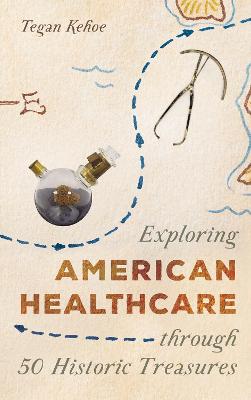(To see other currencies, click on price)
MORE ABOUT THIS BOOK
Main description:
Healthcare history is more than leeches and drilling holes in skulls. It is stories of scientific failures and triumphs.
Exploring American Healthcare History through 50 Historic Treasures presents a visual and narrative history of health and medicine in the United States, tracing paradigm shifts such as the introduction of anesthesia, the adoption of germ theory, and advances in public health. The book provides windows into ordinary people's experiences with different schools of thought about treatment, from patent medicines and faith healing to hospital-based clinical trials. Exploring American Healthcare History showcases little-known objects that illustrate the complexities of our relationship with health, like a set of teeth from a small town in Arkansas where the link between fluoride and dental health was first discovered. It also highlights famous moments in medicine, such as the discovery of penicillin, and puts them into social and cultural context.
Exploring American Healthcare History through 50 Historic Treasures will discuss concepts that are key to history curricula and to using history as a lens to understand society. The concepts include healthcare's intersection with race, law, and changing cultural attitudes in a society shaped by science, religion, and economic forces. The choice of "healthcare" as the focus reflects the fact that the book encompasses conventional medicine, surgery, nursing, alternative medicines, and public health. The book discusses some areas of healthcare history in which practitioners were led by bias or greed rather than evidence. Some patent medicines, for example, lived up to their reputation as get-rich-quick schemes for their inventors. A few of the historic artifacts in the book, such as eugenics medals awarded to families with "good" genes, are treasures in the sense that they are a vital connection to shameful episodes in our past. The book explores artifacts and historic sites as individual things or places with their own stories, and as objects and sites representative of larger trends.
This full-color book with over 50 photographs of artifacts like a beer advertised as harnessing the health-giving power of the sun show how the advancing science of health touched people's everyday lives as well as their doctor visits. Patent medicines and machines highlight ways that people avoided or reacted to mainstream medicine, like faith healing, commercial nostrums, and alternative medicine. Thermometers and mold-culturing pans provide a tour of developments such as professional nursing and the "miracle drug" penicillin, while offering insight into epidemics from tuberculosis, plague, and the 1918 flu to HIV and opioid misuse. Historical caregivers featured include Pedro Jaramillo, a Mexican-American curandero, Dr. Susan LaFlesche Picotte, a trailblazing Omaha medical doctor, and Mattie Donnell Hicks, a Black nurse who served with both segregated and integrated units in the Army Corps of Nurses. This book describes the days when surgeons worked on patients without anesthesia and wiped their scalpels on their coats, and the day that EMTs raced to provide help when the Twin Towers were attacked in 2001, providing insight relevant to today's problems and colorful anecdotes along the way.
PRODUCT DETAILS
Publisher: Rowman & Littlefield
Publication date: February, 2022
Pages: 280
Dimensions: 152.00 x 239.00 x 20.00
Weight: 699g
Availability: Available
Subcategories: General Issues

